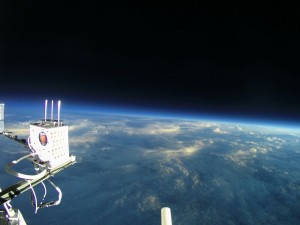 The American Institute of Aeronautics and Astronautics (AIAA)-IIT team was recently at the Columbia Scientific Balloon Facility (CSBF) base in Fort Sumner, N.M. as part of High Altitude Student Platform (HASP)—a balloon flight program supported by the NASA Balloon Program Office (BPO) and the Louisiana Space Consortium (LaSPACE). On September 7, 2015, under the guidance of trained NASA engineers, the team’s Scarlet Hawk III was launched into the stratosphere. The 23-hour flight—which was live-streamed online with data available in real time—saw the balloon rise to an altitude of 36 kilometers.
The American Institute of Aeronautics and Astronautics (AIAA)-IIT team was recently at the Columbia Scientific Balloon Facility (CSBF) base in Fort Sumner, N.M. as part of High Altitude Student Platform (HASP)—a balloon flight program supported by the NASA Balloon Program Office (BPO) and the Louisiana Space Consortium (LaSPACE). On September 7, 2015, under the guidance of trained NASA engineers, the team’s Scarlet Hawk III was launched into the stratosphere. The 23-hour flight—which was live-streamed online with data available in real time—saw the balloon rise to an altitude of 36 kilometers.
This was the third consecutive year that the Illinois Tech team was chosen as one of 12 universities from across the nation to have a student-made satellite payload launched from the New Mexico desert. Team leaders were given the green light for launch at a NASA gathering in Palestine, Texas, following comprehensive component calibration, vacuum and heat testing, and flight simulation.
On the heels of last year’s payload, which included an autonomous solar power system, the Scarlet Hawk III established an individual communication system between earth station and the payload—different than the one provided by NASA. This mission is a part of a larger multi-year team goal to design, build, and launch a small satellite into orbit.
To allow for the 2016 mission to focus on more experimental endeavors, this year’s team built from scratch a reusable, rugged structure from 6061 aluminum. In parallel, the team designed, manufactured, and integrated circuit boards, antennas, sensors, and controllers. The communication system aimed to monitor and control the payload, receive data, and allow intervention in case of a system failure. The payload also monitored environmental parameters such as temperature, pressure, humidity, and light exposure, while also capturing high-definition pictures.
The mission was a success as the communication system was established in different transmission modes; parameters measured by the payload sensors were identical to the ones measured by the NASA system.
Typically, HASP requests student payload flight applications in the fall prior to the flight year. These applications are then reviewed by both the BPO and LaSPACE, and a selection is made by January of the flight year. Student payload integration with HASP is then accomplished during July/August just prior to the flight.
The AIAA-HASP team is a multidisciplinary group of graduate and undergraduate students who volunteer their time and share interest in aerospace science.
Special thanks to John Welin from the Idea Shop and Stan Johnson from the Machine Shop for all the help in manufacturing the structure and boards.
Click here to view photos from the balloon launch. Watch a time-lapse video of the launch here.
HASP project
AIAA-IIT
HASP Flight 665N info
Flight GPS-track
